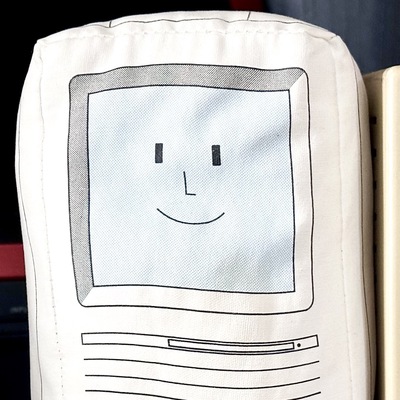Remember, this was way before Windows.
it’s 1994
Windows 3.1 came out in 1992. Yes you still were in DOS a lot back then, but it was hardly “way before windows”.
Speaking of just hunting for random stuff in DOS, my personal favorite “what’s this?” in DOS was Gorillas.bas https://en.wikipedia.org/wiki/Gorillas_(video_game)?wprov=sfti1
I agree, but Windows 3.x was more a shell on top of MSDOS and had a more niche market, and windows 95 didn’t get most popular OS until late 1998. So for a lot of people that was way before windows. Also tech went a lot faster back then. Updates to an old system isn’t as important if it’s not connected to the world of online hackers.
Windows 95 was also a shell on top of MSDOS. Windows NT wasn’t running on top of DOS, but it was primarily for business use until Windows XP.
This is a common misconception, and it’s funny that people still believe it all these years later.
While it’s true that Windows 95 relied on MS-DOS for bootstrapping and provided a DOS-like interface for running legacy applications, it wasn’t “just a shell” on top of DOS. Windows 95 introduced a 32-bit multitasking environment, a completely new user interface, and a separate set of APIs for software development (Win32). It had its own kernel that provided services like memory management and hardware abstraction, separate from DOS.
The integration with DOS was mainly for backward compatibility, allowing users to run older software. But once you were in the Windows 95 environment, DOS was essentially sidelined, and Windows 95’s own features and architecture took over.
Exactly, here’s the canonical The Old New Thing post on the topic. https://devblogs.microsoft.com/oldnewthing/20071224-00/?p=24063
tldr:
“MS-DOS served two purposes in Windows 95: It served as the boot loader. It acted as the 16-bit legacy device driver layer.”“Among other things those drivers did was “suck the brains out of MS-DOS,” transfer all that state to the 32-bit file system manager, and then shut off MS-DOS.”
It’s a bit more complicated than that. Windows 95 used MSDOS to boot, but once it was booted, it completely removed any trace of MSDOS and replaced it with its own MSDOS subsystem. It’s more like MSDOS was a shell on top of Win95, but MSDOS was required to get the kernel loaded.
deleted by creator
I’m pretty sure I still have Gorillas on my HDD, carried with me from my families 286.
Yeah, Gorillas was awesome … came with MSDos 6 IIRC
deleted by creator
Drivespace was what enabled me to play Baldurs Gate 1 back in the day. My specs back then:
- 32MB RAM
- Pentium166 MMX
- 500ish MB drive (My 2GB went bust, so I used an old spare drive for quite a while)
- 16X CDROM
- 2X CD Burner… yarr, that made me a lot of money
- 3dFX Voodoo2 8MB coupled with an ATI Rage Pro
- Soundblaster Live
wooo, look at mr high end over here :-)
640kb RAM 2 x 512 floppies CGA green screen / monochrome
That wasn’t my first PC, just the one on which I played BG1 and used drivespace. My 1st PC was more like the generation after yours. 386 of some sort, 2x 3.5" floppies, and a whooping 43MB harddisk.
Sounds similar to my 2nd. 386SX with 20mb hd. 4mb RAM. She was a beast.
deleted by creator
Between this and RAMDOUBLER my PC was
unstableunstoppable! ;-)And then the Internet happened and we could freely download as much ram as we wanted to!
I remember there was one program that claimed it would update the microcode on your CPU to allow you to basically update your CPU for free to a newer type of processor, for example making your 486 operate like a pentium pro.
Entirely fake, but given the miracles of the time it seemed plausible.
I used the proprietary predecessor, Stacker.
It was pretty magical. It turned my 40 MB hard drive into a (seemingly) 80 MB hard drive.
I don’t remember there being a significant performance penalty, because it was presumably overshadowed by the relatively (compared to processor speed) slow disk speeds.
Both times I used either one of them, it crashed in the middle of compressing my hard drive and I had to reformat. But they worked fine the 2nd try!
“I don’t remember a performance penalty, because everything was so slow it didn’t matter”
Stacker was the one I used also. It really did work
These days, modern filesystem like ZFS has compression and data deduplication (identical data only stored once) support, as well as other useful features such as snapshots and copy-on-write.
This was the nerdiest “Choose your adventure” rpg but it was a fun read.
The idea is still around! Apple’s APFS file system (and HFS+in its later days) support sort-of transparent compression, and on all its platforms most system files - the ones that don’t change much - are compressed to save space for user files. There’s surprisingly little documentation about this.
There’s a third party tool you can use to compress files yourself: https://github.com/RJVB/afsctool
It looks like the technical details are in this pdf: https://developer.apple.com/support/downloads/Apple-File-System-Reference.pdf
Btrfs has compression as well. It compressed my root partition to a third of it’s size. It helps out with some games as well, but they usually are not as compressible. The performance impact is pretty minimal as long as you don’t set the compression level excessively high.
We used a similar program for Windows 3.11, “doublestack” or something. It did work. It did make it a lot slower. We used it on one of the drives.
Laughs in PKUNZIP.EXE
wow, that was a blast from the past… thank you
Stacker, then MS ripped off Stacker and made Doublespace, got sued and changed the compression algorithm and renamed it DriveSpace.
Couldn’t use DoubleSpace or Stacker with Windows 3.X, there was no 32bit driver so disk access was horrendously slow. Windows95 was needed to use DriveSpace with full driver support, but it was still slow and by that time hard drives had caught up with the growing size of the OS and applications somewhat and live disk compression lost popularity, particularly with the way DriveSpace did it. Storing your entire drive as a single giant file backed by FAT32 was a terrible idea and prone to corruption.
When NTFS came around and introduced transparent file compression, that pretty much ended DriveSpace style compression. All modern FS now include some kind of compression, NTFS, APFS, BTRFS, ZFS. Even HFS+ had some ability to compress similar to APFS, but wasn’t very well known.
Which came first, DriveSpace or Norton Speed Disk? I thought Norton was first.
Didn’t speed disk do an optimised defragment operation, putting OS files at the start of the drive etc
Different tools. Speed disk was a disk defragmenter, DriveSpace was whole disk compression. The Norton tool you’d have used a lot if you used DriveSpace was Norton Disk Doctor.
And as I recall, Norton had all the tools long before MS-DOS included them by default. It was sort of a dick move by Microsoft, the sort of thing they’re famous for now.
Raise your hand if you used to sit and watch Norton’s defragger do its thing! 🤩
DOS has always? had chkdsk, but ndd had a knack for being able to recover data from minor corruptions way better than chkdsk did. Scandisk (dos 6 version of chkdsk) was just a prettier face, ndd was still better.
Between ndd, Spinrite, and I can’t remember the name of the undelete tools, I saved a lot of homework assignments.
chkdsk in dos never had the ability to scan the disk surface for defects, ndd did that, and then magically scandisk showed up and looked awfully similar to ndd.
But I agree, some really great tools. And sysinfo was our de facto “how fast is this thing?” for years.
Indeed. It really was the end of an era when they went to shit.
Did anyone figure out if scandisk was actually licensed from someone else? I know that lots of the other MS utils were - defrag, undelete etc
I believe so yes
But look at that estimation screen! Again, rant all you wish, Microsoft knew how to handle a long running task even back in MS-DOS days. In this case, it’s estimated at 46 minutes. Great!
Meanwhile, today it’s often just “beachball!”. It’s become a bit of a lost art.
on my old Windows 95 laptop I used the drive compression to create a partition to put some games on it, worked pretty well

This was a double edged sword. For a while I wanted to play with Windows 95, and my hard drive wasn’t large enough. So what I did is I’d run drivespace on dos 6.22 which would double the size of the drive reported and let me install windows 95.
Big problem is that this is prior to journaling filesystems, and Windows 95 was buggy as hell. So windows 95 would crash, it would damage the File Allocation Table, the drivespace file would get corrupted, and you’d have to reinstall windows from scratch all over again.
Really frustrating era of computing, but on the other hand, something like drivespace made the impossible possible even if it was flawed, and many such technologies were coming out that were like that. Video game console emulation in the late 90s was another such thing that was like “What? This shouldn’t be possible…should it?”, as well as stuff like downloading video or audio, or even voice chat over a modem which is sort of insane when you think about it.
So a lot of stuff was frustrating and broken, but also miraculous and impressive. Really interesting time to be in love with computers as a hobby.













